Latest News
Kohli 100* headlines India’s comprehensive win against Pakistan
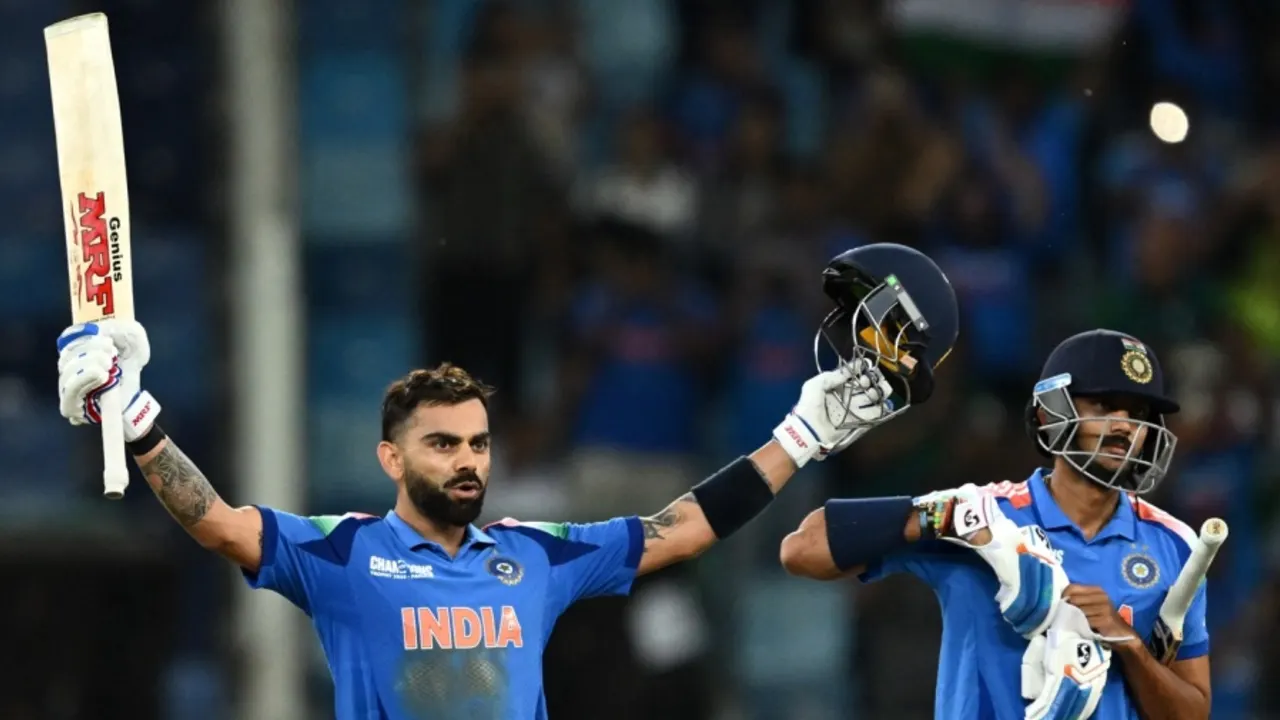
In the biggest match of the year, with his mortality showing more than it ever used to, Virat Kohli proved he’s still got it, that maybe, just maybe, the little he’s lost isn’t going to define him. He ticked off 14,000 runs in ODI cricket, brought up his 51st ODI century, set up India for a semi-final spot and essentially crossed out Pakistan from the 2025 Champions Trophy. The holders and the hosts need other results to go their way to stay alive in the tournament now.
India went into the game as favourites. They were worthy of that seeding, limiting Pakistan to 241 with Hardik Pandya putting in the kind of performance that should make him illegal. An allrounder capable of dismissing the opposition’s best batter, and then coming back to take down their top-scorer, isn’t just a name on the sheet. He is the secret sauce.
And Kuldeep Yadav was the spice. His left-arm wrist-spin is so rare and he made it rarer by finding a way to be quick through the air without compromising on turn or accuracy. So that means unless batters pick him out of the hand, they are always going to be guessing. Three Pakistan batters guessed wrong. All three were end-overs wickets. Pakistan were setting up to explode at the death. Kuldeep just wouldn’t let them. The injury hasn’t affected his menace.
Pakistan were able to produce moments. Shaheen Shah Afridi sending down a 143kph inswinging yorker to shatter Rohit Sharma’s stumps. Abrar Ahmed conjuring a carrom ball from hell to get rid of a rampaging Shubman Gill. But when it came to capitalising on them, they just couldn’t. The result was a world champion side that was renowned for pulling games out of the fire now seems to do the first part right – they definitely got into trouble in Dubai – but the other part, the important part is going so very wrong. Pakistan were 151 for 2 in the 34th over before they were bowled out for 241 with the most inexperienced member of the India side dictating terms, Harshit Rana and his slower balls were just impossible to hit.
A game in an ICC event and a rivalry with history bursting out of it eventually became so one-sided that its last few moments were dominated by an individual pursuit. Axar Patel turned down an easy two so Kohli could pursue his hundred. The crowd in Dubai loved that. There were 12 runs to get for India’s victory and 12 runs to get for their hero’s century and they chanted his name over and over. Pakistan were nowhere to be found. Ever since a collapse of 3 for 11 in 19 balls, this game turned pear-shaped for them.
Mohammad Rizwan had banked on the innings going so differently. He came in at 47 for 2 and hit his first ball for four and then decided run-scoring was not for him. He was 24 off 50. He barely hit the ball in anger. He point blank refused to. At the other end, Saud Shakeel was at least making an effort to turn the good balls he was facing into singles. When he got to fifty, he had weathered only 29 dot balls. At the same time, Rizwan at the other end, had racked up 40. India did well by denying him spin to start his innings. But still, this was a better pitch than the opening game in Dubai a few days ago. It wasn’t flat, but it had a little more pace in it, and it got better under lights. Rizwan, though, batted like it was cursed. He was worried bad things would happen if he tried to hit the ball hard.
And it kinda did. Rizwan fell trying to hit Axar out of the ground and his wicket triggered a collapse. Shakeel fell in the next over and Tayyab Tahir followed soon after. India, having spent 320 deliveries across two matches searching for a wicket in the middle overs, had found three in the space of four. Pakistan were 165 for 5. Soon they would be 200 for 7, having to negotiate the last 7.1 overs of the innings with their tail exposed.
India’s discipline never let Pakistan off the hook and leading the way was Hardik, banging the ball just short of a length on a pitch that was offering a bit of grip and some tennis-ball bounce. He took out Babar Azam at a time when India’s lead fast bowler, Mohammed Shami, was off the field with a shin problem and he did Shakeel for lack of pace just after the left-hander had smacked him for four. He always knew what to do to exploit the conditions and make the batter’s life miserable. On the back of his work, Kuldeep and Rana bowled 6.4 death overs for 28 runs and picked up four wickets.
Gill was the star of India’s chase early on, a conscious effort to keep his front foot from moving too far forward and across leaving him excellently placed to take advantage of Afridi and his full length deliveries when there was no swing on offer. When he rammed the Pakistan fast bowler down the ground and then one-upped it by coming down the track and lifting the ball into the sightscreen, it looked like it was going to be his day. Abrar intervened with a ball that drifted in through the air, tempting the right-hander to close the face of his bat, and turned away to rattle middle and off stump. Gill was stunned.
Kohli, too, offered a shrug of his shoulders. He looked vulnerable against Abrar too and was almost bowled playing back to him. But against the quicks, he was vintage. He went past 14,000 runs with a crisp cover drive off Haris Rauf. All of Pakistan’s best bowlers offer pace on the ball. And that is Kohli’s happy place. A batter of his quality needs to be made uncomfortable at the crease when he is new. He had been dismissed five times in his last six ODIs by legspin. Pakistan had one of those and they felt they couldn’t go to him.
Shreyas Iyer helped himself to a half-century. A little change in his technique where he holds his bat higher and waves it as the bowler approaches, creating momentum into his shots, is helping him deal with an earlier weakness against the short ball. He clubbed Rauf for four in front of square to prove it. But there was no taking the spotlight from his senior partner.
Kohli was setting the tempo. Pakistan had allowed to do so. Though he only hit three of his first 62 balls to the boundary, he already had fifty runs to his name. He knows how to score quickly without looking for big shots. The ball wasn’t stopping on the surface as much under lights. Things were working in his favour again. He almost knew he was going to get a hundred. He demanded an explanation when Axar turned down a second run off a wide in the 42nd over when it was clear to everybody else that all he was doing was make sure Kohli had the best chance to get to three-figures with time running out. When he did, off the last ball of the match, Kohli looked to the dressing room and literally said “I told you. Relax”. That was how easy this was. That was how inevitable he was.
Brief scores:
India 244 for 4 in 42.3 overs (Rohit Sharma 20, Shubnam Gill 46, Virat Kohli 100*, Shreyas Iyer 56; Shaheen Shah Afridi 2-74) beat Pakistan 241 all out in 49.4 overs (Saud Shakeel 62, Babar Azam23, Mohammad Rizwan 46, Khushdil Shah 38; Hardik Pandya 2-31, Kuldeep Yadav 3-40)by six wickets
[Cricinfo]
Latest News
Over 150 dead in Myanmar and Thailand after huge earthquake
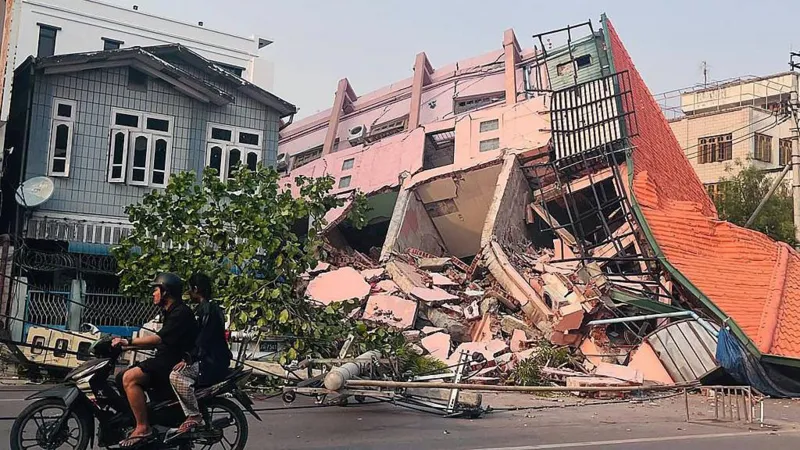
A huge 7.7 magnitude earthquake has hit central Myanmar, according to the United States Geological Survey (USGS).
At least 144 people have died and 732 have been injured so far in the country, Myanmar military leader Min Aung Hlaing said.
The epicentre was 16km (10 miles) north-west of the city of Sagaing, sending strong tremors that were felt as far as south-west China and Thailand.
Meanwhile, around 100 construction workers are missing after an unfinished high-rise building collapsed hundreds of miles away in Bangkok, according to Thailand’s deputy prime minister.
At least seven people have died at the site in Thailand, according to the Bangkok Metropolitan Administration.
A rescuer in Mandalay, Myanmar’s second-largest city, told the BBC the damage is “enormous”.
The total number of people killed and injured by the earthquake are expected to rise in the coming days.
There have been reports of roads buckling in the capital of Nay Pyi Taw, and the country’s military government has declared a state of emergency in six regions.
The earthquake struck near Mandalay, which has a population of about 1.5 million people.
A second quake struck 12 minutes after the first, according to the USGS, with a magnitude of 6.4 and its epicentre was 18km (11.1 miles) south of Sagaing.
Myanmar, formerly known as Burma, gained independence from Britain in 1948, but its recent history has been marked by unrest and conflict.
The military seized power in 2021, ten years after agreeing to hand over control to a civilian government. Since then, the junta has cracked down hard on dissent, executing democracy activists and jailing journalists. The state controls almost all local radio, television, print and online media, and Internet use is restricted in the country, which often makes access to information difficult.
According to a recent BBC data project, the country is now controlled by a patchwork of groups, making relief and recovery efforts more challenging.
It is even harder to find accurate information about what is going on in rebel-held areas of the country.
The junta made a rare call for international assistance in the wake of the earthquake.
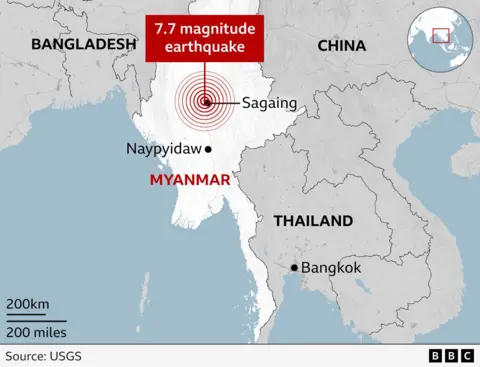
However, the complex situation on the ground is likely to hamper search and rescue operations as well as the free flow of aid into the country.
Rescue workers operating in villages near Mandalay have told the BBC they do not have access to the heavy machinery needed to reach people trapped under the rubble. “We’re digging people out with our bare hands,” one man said.
The earthquake has added pressure to an already dire humanitarian situation in the country, where 3.5m people are estimated to have been displaced by fighting.
The Sagaing region, near the epicentre of the quake, is a volatile key battleground in the civil war.
Charities and opposition parties working in the country have raised concerns about the “politicisation” of aid in the coming days.
Montse Ferrer, the deputy director of East and Southeast Asia and the Pacific at Amnesty International, told the BBC the junta has “a history of denying aid” to areas where resistance forces are active.
The tremors were felt hundreds of miles away in Thailand’s capital of Bangkok, where rescue teams worked through the night to free the construction workers trapped beneath the rubble.
Buildings across the city were evacuated, including a hospital holding patients in acute need of medical attention. A woman gave birth on the street amid the commotion, lying on a stretcher surrounded by hospital staff.
Bui Thu, a BBC journalist who lives in Bangkok, told the BBC World Service’s Newsday programme that she was at home cooking when the initial quake happened. “I was very nervous, I was very panicked,” she said.
“Buildings in Bangkok are not engineered for earthquakes, so I think that’s why I think there’s going to be big damage.”
Thailand’s Prime Minister Paetongtarn Shinawatra visited the site of the collapsed building on Friday afternoon.
Search and rescue teams using drones, sniffer dogs and diggers have been mobilised and disaster centres set up to help with the rescue operation.
Latest News
IPL 2025: Patidar, bowlers lead Royal Challengers Bengaluru to first win over Chennai Super Kings in Chennai since 2008
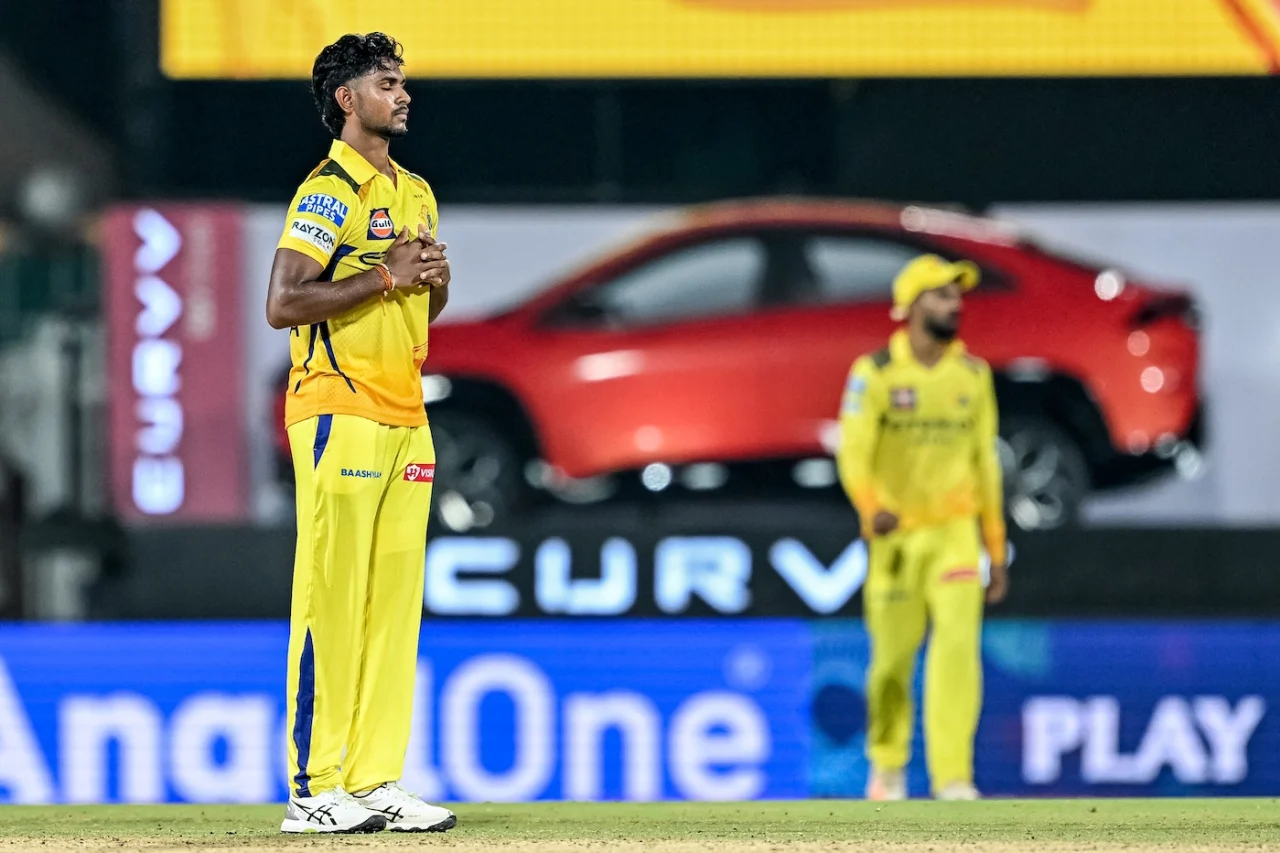
Royal Challengers Bengaluru (RCB) ended their Chennai jinx in style, beating Chennai Super Kings (CSK) there got the first time since the first IPL – by a whopping 50 runs, CSK’s biggest defeat at home. The contest was so dead that more than half of CSK’s chase was all about finding out if and when MS Dhoni would bat. He eventually did so at No. 9, only for the second time in his career.
The build-up was all about how RCB would tackle 12 overs of spin, but the conditions rolled out inverted the spotlight: how would CSK handle eight overs of traditional seam and swing from Bhuvneshwar Kumar and Josh Hazelwood? Not very well, as their combined figures of 7-0-41-4 demonstrated.
And that after RCB’s batters dominated the CSK attack on what was not a straightforward pitch. Like Hazlewood and Bhuvneshwar, Khaleel Ahmed drew seam movement and extra bounce, but CSK didn’t have any more such bowlers. Rajat Patidar led RCB’s innings, full of intent, capitalising on a dropped catch when he was on 17, and finishing with 51 off 32 balls. Ravichandran Ashwin and Ravindra Jadeja were allowed to bowl only five overs, which were taken for 59 runs.
Khaleel drew some seam movement and uneven bounce in the first over, but CSK hadn’t planned for such conditions. They don’t have quick bowlers who can hit the good length and just short. They were going to open with Ashwin, and they did. Only for the first ball to not come out right and for Phil Salt to pull him for a six. The over went for 16, forcing the early introduction of Noor.
On his way to the Purple Cap, Noor and Dhoni recreated a lightning stumping to get rid of Salt for 32 off 16 balls, but Devdutt Padikkal denied them any relief. The left-hand batter took down Jadeja in ways Jadeja is not accustomed to: a sweep and a charge down the wicket to consign him to a 15-run first over.
When Ashwin got Padikkal out for 27 off 14 deliveries, CSK would have hoped to re-establish control. But the presence of Patidar meant they were not able to bowl spin at Virat Kohli, who struggled to achieve even a run a ball. Patidar took a six off Noor the moment he overpitched. Kohli, playing Matheesha Pathirana for the first time, took 16 runs off his second over, and RCB were 109 for 2 in 11 overs.
Like Ashwin earlier, Jadeja nearly had his own back when he drew a mis-hit from the enterprising Patidar, but Deepak Hooda dropped a sitter at long-off. In the next two overs, Patidar offered three half-chances, but none of them was taken. Kohli’s offering was taken, though, and the pressure on Liam Livingstone, and eventually his wicket, reduced RCB to 145 for 4 in the 16th over.
RCB kept the intent up, though, and Jitesh Sharma hit the second ball he played for the shot of the match, an inside-out drive off a Noor wrong’un over extra cover for six. Patidar played a delectable pick-up shot off a Pathirana slower ball in the next over. This 27-run stand in 13 balls gave RCB the impetus they needed before the death overs.
In the death overs, though, both fell, even resulting in just one run off the 19th over, bowled by Pathirana. However, Tim David took them 20 past what CSK believed to be par with three sixes in the last over, bowled by Sam Curran, who has now bowled four overs for 47 runs in two matches.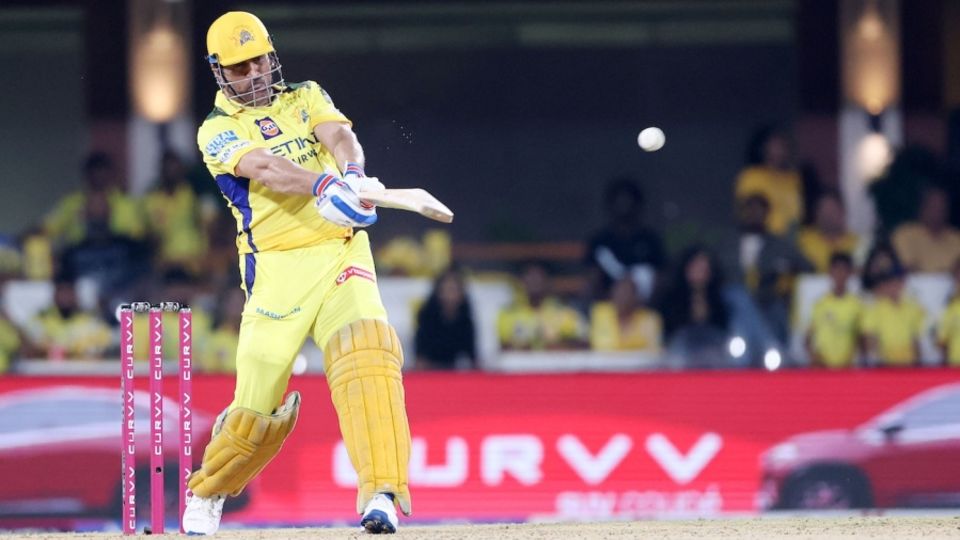
Hazlewood got Rahul Tripathi and Ruturaj Gaikwad in his first over with steep bounce, and Bhvuneshwar took his 73rd powerplay wicket when he nicked off Hooda.
Dhoni kept teasing his fans by batting after Jadeja and Ashwin. Yet there were 4.4 overs left when he walked out to bat at No. 9. Only in the last two overs did he get some hits in, but couldn’t avoid a record home defeat.
Brief scores:
Royal Challengers Bengaluru 196 for 7 in 20 overs (Rajat Patidar 51, Phil Salt 32, Virat Kohli 31, Devdutt Padikkal 27, Liam Livingstone 10, Jitesh Sharma 12, Tim David 22*; Khaleel Ahmed 1-28, Ravichandran Ashwin 1-22, Noor Ahmad 3-36, Maheesha Pathirana 2-36) beat Chennai Super Kings 146 for 8 in 20 overs (Rachin Ravindra 41, Shivam Dube 19, Ravindra Jadeja 25, Ravichandran Ashwin 11, MS Dhoni 30*; Bhuvneshwar Kumar 1-20, Josh Hazlewood 3-21, Yash Dayal 2-18, Liam Livingstone 2-28) by 50 runs
[Cricinfo]
Latest News
Two powerful earthquakes kill several, trap dozens in Myanmar, Thailand
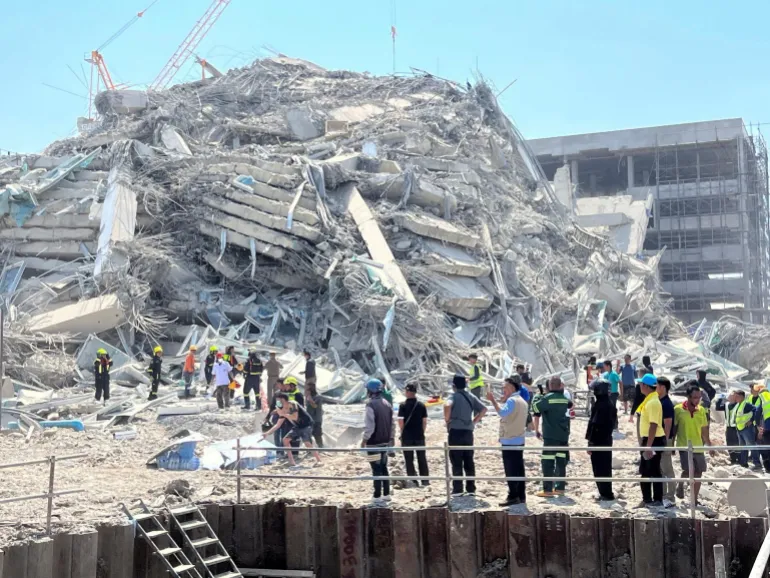
Magnitude 7.7 and 6.4 earthquakes have struck Myanmar, killing at least three in Thailand’s capital Bangkok and trapping dozens others after an under construction building collapsed.
The first tremor hit 16km (10 miles) northwest of the city of Sagaing at a depth of 10km (6 miles) at about 12:50pm (06:20 GMT) on Friday, the United States Geological Survey (USGS) said.
Myanmar’s ruling military declared a state of emergency in six regions and states. “The state will make inquiries on the situation quickly and conduct rescue operations along with providing humanitarian aid,” it said on the Telegram messaging app.
A major hospital in Naypyidaw was declared a “mass casualty area”, an official at the facility told AFP news agency. Rows of wounded were treated outside the emergency department of the 1,000-bed general hospital, some writhing in pain, others lying still as relatives sought to comfort them.

According to two witnesses from the town of Taungnoo in Bago region who spoke to Reuters news agency, at least three people died after a mosque partially collapsed. “We were saying prayers when the shaking started … Three died on the spot,” one of them said.
Al Jazeera’s Tony Cheng reporting from Naypyidaw said he was outside Myanmar’s Defence Services Museum when the earthquake hit, right after interviewing a government spokesman. “We’d just stepped outside to say goodbye when things started shaking,” Cheng said, adding he and others sought shelter under a doorway as large roofing and side panels crashed down.
The tremors began gently but quickly intensified, causing concrete panels to break off the building, Cheng noted. “I’ve been in earthquakes in this region before, and I’ve never felt anything as strong as that,” he said. “We have felt a considerable number of aftershocks. It put everybody here on edge.”
Social media posts from Mandalay, Myanmar’s ancient royal capital that is at the centre of its Buddhist heartland, showed collapsed buildings and debris strewn across streets of the city.
A witness in the city Htet Naing Oo told Reuters that a tea shop had collapsed with several people trapped inside. “We couldn’t go in,” she said. “The situation is very bad.”
Marie Manrique, programme coordinator for the International Federation of the Red Cross said to reporters in Geneva, via video link from Yangon that the organisation anticipates the impact to be “quite large”.
“Public infrastructure has been damaged including roads, bridges and public buildings. We currently have concerns for large scale dams that people are watching to see the conditions of them”, she said.
Skyscraper collapses in Bangkok
In neighbouring Thailand’s capital Bangkok, at least three people were killed when a 30-storey under-construction tower collapsed, Thailand’s Deputy Prime Minister Phumtham Wechayachai announced. He added that 81 people were trapped under the rubble of the building.
Al Jazeera’s Imran Khan who was in the city when the earthquakes struck, said the entire public transport system has been shuttered for safety reasons.
“People are out on the streets here. None of the trains are moving,” he reported. “Traffic is absolutely gridlocked. The buildings have been shuttered in the centre of the city.”

Thai Prime Minister Paetongtarn Shinawatra announced a state of emergency in her country. Meanwhile, Bangkok has been declared a disaster area, the capital’s city hall said on Friday.
Urban rail systems in Bangkok were temporarily closed but expected to resume services on Saturday.
The earthquakes were also felt in the Yunnan and Sichuan provinces in China, causing injuries and damage to houses in the city of Ruili on the border with northern Myanmar, according to Chinese media reports.
Videos that one outlet said it had received from a person in Ruili showed building debris littering a street and a person being wheeled on a stretcher towards an ambulance.
Cambodia, Bangladesh and India also reported tremors.
Previous quakes in Myanmar
Earthquakes are relatively common in Myanmar, where six strong quakes of 7.0 magnitude or higher struck between 1930 and 1956 near the Sagaing Fault, which runs north to south through the centre of the country, according to the USGS.
A powerful 6.8-magnitude earthquake in the ancient capital Bagan in central Myanmar killed three people in 2016, also toppling spires and crumbling temple walls at the tourist destination.
The impoverished Southeast Asian nation has a strained medical system, especially in its rural states.
Moreover, Al Jazeera’s Cheng said it was important to remember that Myanmar was a country currently in the grips of a bitter civil war.
“A lot of the people have moved from the countryside into the cities to try and escape,” he noted. “That has meant it is densely overcrowded and the building standards are not particularly strong.”
[Aljazeera]
-

 News7 days ago
News7 days agoSeniors welcome three percent increase in deposit rates
-

 Features7 days ago
Features7 days agoThe US, Israel, Palestine, and Mahmoud Khalil
-

 News7 days ago
News7 days agoScholarships for children of estate workers now open
-
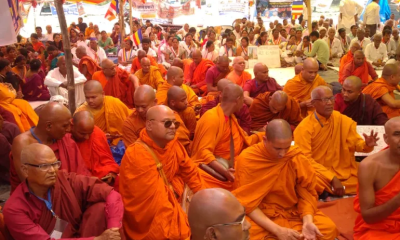
 Foreign News5 days ago
Foreign News5 days agoBuddhism’s holiest site erupts in protests over Hindu ‘control’ of shrine
-

 News7 days ago
News7 days agoJapanese Defence Delegation visits Pathfinder
-

 Features4 days ago
Features4 days agoCelebrating 25 Years of Excellence: The Silver Jubilee of SLIIT – PART I
-

 Editorial6 days ago
Editorial6 days agoWhen tractors become cars!
-
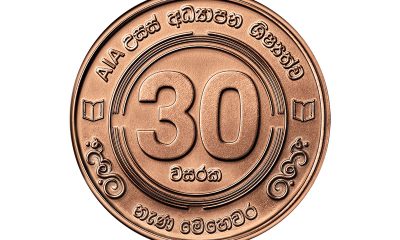
 Business2 days ago
Business2 days agoAIA Higher Education Scholarships Programme celebrating 30-year journey











